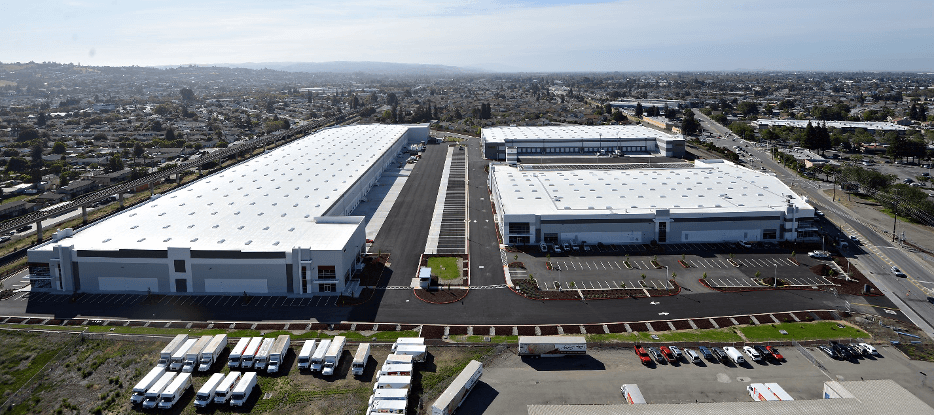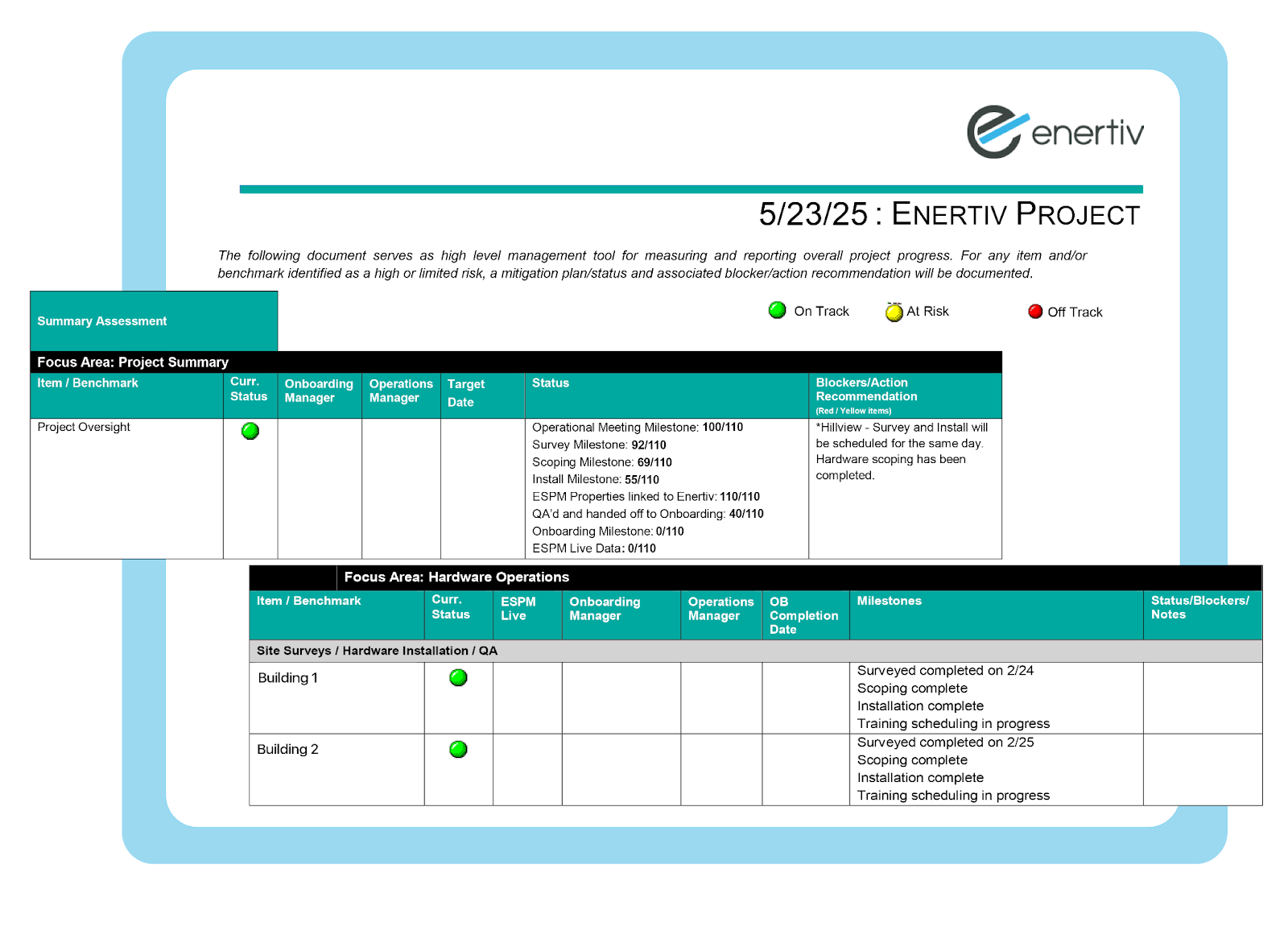
Top 10 Global Asset Management Firm deploys Enertiv to get 100% utility data coverage across 100+ industrial sites











The Problem
One of the world’s largest asset management firms needed to increase utility data coverage to improve its GRESB score. Utility data coverage is one of the highest-impact contributors to the assessment. The biggest challenge came from its industrial portfolio: triple net leased properties with utility accounts under tenant control.
Requesting this data directly from tenants was inefficient. Responses were delayed, incomplete, or never submitted. Overburdened property managers spent hours trying to collect and compile the required information.
The firm also has public net zero commitments by 2050. Without visibility into tenant consumption, any emissions planning or tracking was severely limited.
The Challenge
The firm reached out to the Enertiv team in mid-2024, looking to increase electricity data coverage across the entire industrial portfolio in time for the reporting of 2024 data.
The team decided to move forward with shadow metering — a hardware solution that avoids tenant involvement and delivers complete, real-time data at 15-minute intervals.
So we took on the challenge: deploy this solution across 108 properties within a timeline of just 4 months.
Since this was a nationwide deployment, Enertiv structured the rollout into four geographic regions, each led by a dedicated project manager responsible for coordinating the implementation and maintaining consistent communication with the client.
| Region | State(s) | Total # of Properties |
|---|---|---|
| EAST | FL, IL, PA | 16 |
| SOUTH | AZ, TN, TX | 28 |
| NORTHWEST | OR, WA, NV | 27 |
| SOUTHWEST | CA | 37 |
| TOTAL | 108 | |
Scaled Deployment Steps
Survey
The first — and what we consider the most important — step was the site survey. Enertiv’s team visited each site in person to understand the local electrical infrastructure, map the meters, identify their types and locations, and uncover any potential installation nuances.
Without this, it's typically necessary to request information from property managers, and since each one usually manages 20 to 40 sites, that could significantly delay a large-scale deployment with a tight timeline like this one.
Digitalization and Operational Inventory
While on site, Enertiv also conducted a full infrastructure survey: equipment, meters, panels, and circuits were photographed, labeled with QR codes, and digitally documented. Each asset received a digital equipment profile including manufacturer, manuals, serial number, and operational condition.
This digital inventory serves as a centralized source of asset information, eliminates the need to rely on property managers, enhances the quality of insights generated by our platform, and provides a foundation for future strategies such as predictive maintenance, asset replacement planning, and decarbonization roadmaps.
Installation
With the surveys completed, Enertiv procured the necessary hardware and began installing the meters and the cellular network connection.
The installation was remotely monitored, with real-time feedback used for quality assurance and to verify data networking and accuracy. Every week, the asset management team received updates like this one:

This was essential to ensure the client’s team was always up to date on what was being done. The meters used by Enertiv are non-proprietary, revenue-grade (no need for calibration using past utility bills), and can be installed without shutdowns, which was critical to maintaining the tight schedule and avoiding operational disruptions.

Integration with Energy Star
After data collection began in real time, Enertiv worked to integrate the system with ESPM, ensuring no data gap between historical and new records. The integration is two-way, meaning data can be extracted and submitted directly through Enertiv’s system without needing to log into Energy Star.
Local Team Training
After the installation, integrations, and data validation were complete, our team trained the client’s property management staff. Beyond delivering the operational system, we focused on ensuring they could fully leverage the capabilities of the platform.
The landlord gained access to a centralized portal with structured and accessible data for the entire portfolio. Each tenant also received access to a dedicated interface to monitor their own consumption.
Beyond Data Coverage: Insights Generated for Landlords and Tenants
This is where Enertiv goes beyond data coverage. Using the electricity data collected by the system, our AI and engineering team began identifying opportunities to optimize consumption, reduce costs, and generate new sources of revenue.
Through our system, we identified:
- $2,100,321 in operational insights. This means that by analyzing meter data, our team was able to identify opportunities for baseload reduction, peak shaving, and weather modulation. These insights are directed to the tenants, who control the meters.
- $91,057 in demand response opportunities, where companies are paid to reduce their energy usage during a few high-demand hours each year. These insights are also directed to tenants.
- $604,530 in community solar opportunities. By analyzing rooftop area, location, slope, and solar incidence, our team delivered an estimate of how much the landlord could earn annually from such implementations.
Each insight includes a dollar value and an associated estimate of carbon reduction. Our engineering and customer success teams are responsible for communicating with tenants and ensuring the insights are implemented efficiently and quickly.
This changes the relationship and dynamic between landlords and tenants.
Tenants get a one-stop shop to access and manage their utility and emissions data, and the landlord becomes a facilitator of savings and sustainability. When renewals approach, the value delivered through the system becomes a compelling lever in lease negotiations.
Results
Enertiv deployed shadow metering across 108 industrial properties within a 4-month deadline. Electrical data coverage jumped from 66% to 100%, and more than $2.8 million in savings and revenue opportunities have been identified so far.
Executing a nationwide deployment on such a tight schedule requires more than just technology — it requires operational experience, precise coordination, and a real understanding of what works.
Now, the team is working with Enertiv on Phase 2: implementing water and gas metering.
As GRESB criteria evolve from data coverage to measuring actual performance, infrastructure like this becomes essential. Shadow metering isn’t just about ticking a box anymore, it’s about enabling the data flows that support measurable decarbonization, tenant engagement, and operational improvements portfolio-wide. And this landlord is already leading the way.
What an insight looks like for the tenant:


Even under triple net leases—where operational costs are outside the landlord’s direct control—this landlord was able to create tangible, strategic impact with Enertiv. By offering a differentiated experience to tenants, they strengthened relationships and increased retention. Additionally, the initiative positioned the landlord to meet portfolio decarbonization goals.





